Michael Leri
Curated From www.comingsoon.net Check Them Out For More Content.
Electronic Arts’ tragic mishandling of the Star Wars license did at least result in one thoroughly great game: Star Wars Jedi: Fallen Order. It was a well-paced action title and far cry from the other Star Wars games at the time that also left plenty of room for improvement. Respawn Entertainment’s Titanfall was a similarly solid idea that was able to flourish with its impeccable sequel. Star Wars Jedi: Survivor does expand upon Fallen Order‘s base by adding more open spaces and a bigger suite of companions, but also stumbles in many of the same ways and fails to be the significantly better second entry it deserves to be.
The combat is the ultimate example of Survivor‘s inability to meaningfully improve. Protagonist Cal Kestis has access to a few more lightsaber types that all have their own stats, strengths, and weaknesses. For example, the Crossguard stance with the Kylo Ren-esque lightsaber is plodding but powerful and the Blaster style adds in a mix of ranged blasting and melee swordplay. All five are different and have a unique array of slashes and swipes, although they aren’t as expansive as they could be and leave a few button combos unused.
However, the game locks players to two at a time and that makes it difficult to experiment. Switching stances has to be a conscious decision and putting that onus on the player means it’s easier to just rely on the most convenient two. There’s also no way to anticipate what is up ahead and what stances will yield the best results; the amount of workbenches and meditation points peppered around that let players swap stances can’t make up for that limitation. Having access to all of them at once would add more variety and utility, both of which are tantalizingly just out of reach here.
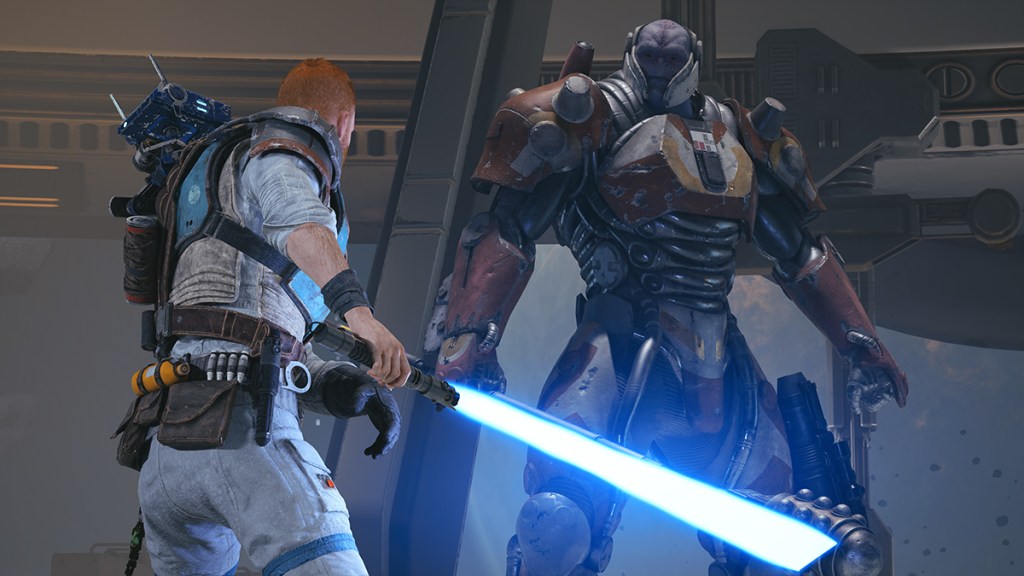
The combat itself is similarly conflicted. Like Fallen Order, Survivor borrows heavily from FromSoftware’s Sekiro: Shadows Die Twice and its parry-based nature that encourages players to wait for openings to strike or break down the opponent’s defensive meter. Circling a Sith warrior, parrying blow after blow, and delivering the fatal slash can be exhilarating because it gamifies the fantasy that’s intrinsic to the franchise.
Framing lightsaber duels after the samurai epics they were modeled after is smart, but Survivor is not built well enough to consistently evoke that feeling. The parry is a bit too sluggish and something players have to do in anticipation rather than on reaction. The window is fairly wide, seemingly to mitigate irritation, but it’s not as satisfying to manually adjust to such a wonky, unnatural window. Reacting quickly and nailing deflections at the last second is a key part of why Sekiro and Wo Long: Fallen Dynasty are so rewarding, and Survivor just isn’t built with the same finesse to elicit similar sensations of satisfaction. Duels are often a test of patience, not reflexes.
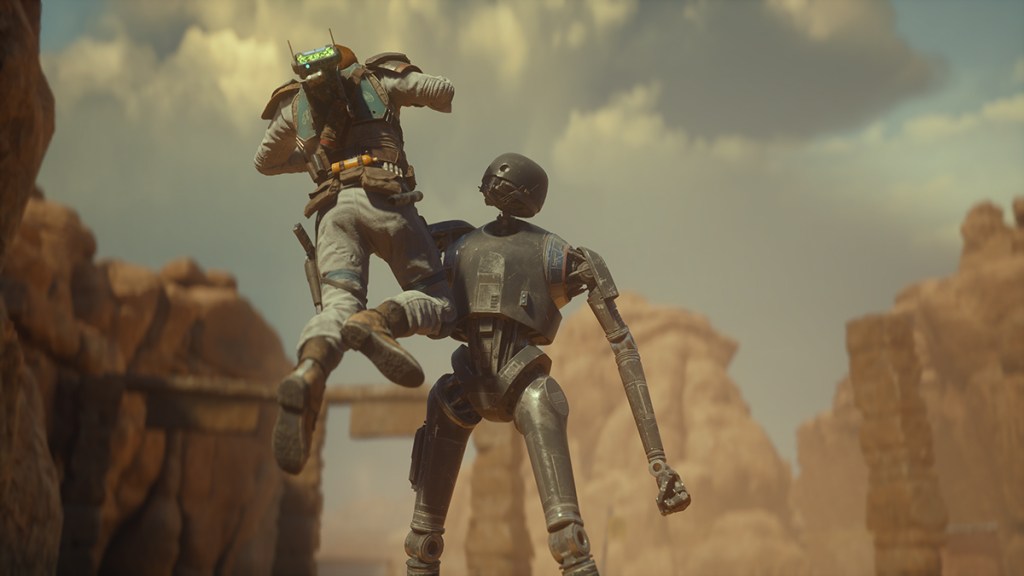
Part of this disconnect also stems from the enemy design that is largely unreactive to Cal’s power. A startling number of foes from the raucous Bedlam Raiders to the Empire’s vast array of droids can just tank through lightsaber slashes as if they were swings from a foam bat. It’s ridiculous from a lore perspective that such a legendarily strong weapon can be so brazenly ignored, but it’s worse for the gameplay because it puts Cal at an arbitrary disadvantage. Cal stumbles when struck, yet that doesn’t apply to enemies and this inequitable approach throws off the rhythm.
Blocking and whiff punishing strikes should be a dance, however, it’s often rudely interrupted by some elite guard who’d rather tango to his own tune and cheaply interject with a flurry of ill-timed hacks. Foes don’t have to play by the same rules and are prone to spamming moves that make the time to strike back tediously small. Having to abide by these narrow and one-sided guidelines is an inelegant way to tackle combat, especially given how Respawn still insists on making players fight so many wild animals. Battles against humans can sometimes be thrilling, but cutting down local fauna is neither empowering nor rewarding since they only highlight all of its mechanical shortcomings without including any of the upsides.
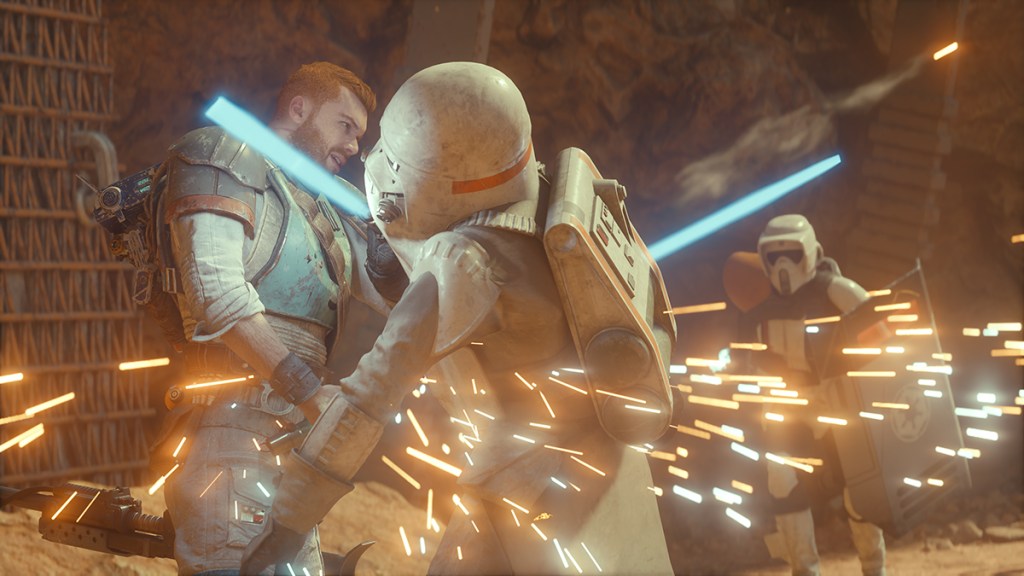
Survivor’s combat inconsistencies can also be attributed to its stubborn adherence to the soulslike formula. Enemies are nimble, but players are still mostly locked to the animation priority that defines most soulslike games. This discrepancy is one of the fundamental reasons behind almost every cheap shot and why many of its longer combo strings are rarely useful. The controls aren’t built for the type of game it is, they’re built for the type of game it wants to be.
But it’s also just unclear why Survivor is even so heavily rooted in the soulslike genre since a couple of its surface-level elements, like having enemies that respawn at save points and the need to chase down experience after death, are so out of place. Resetting the state of the world makes no sense within the narrative and is a vestigial element of the genre Survivor has weirdly clung onto too tightly. Reclaiming experience points (which are prone to glitching out and disappearing) after a death also adds nothing to the game. It’s puzzling why Survivor isn’t just a more straightforward action title with soulslike undertones instead of a misguided hybrid.
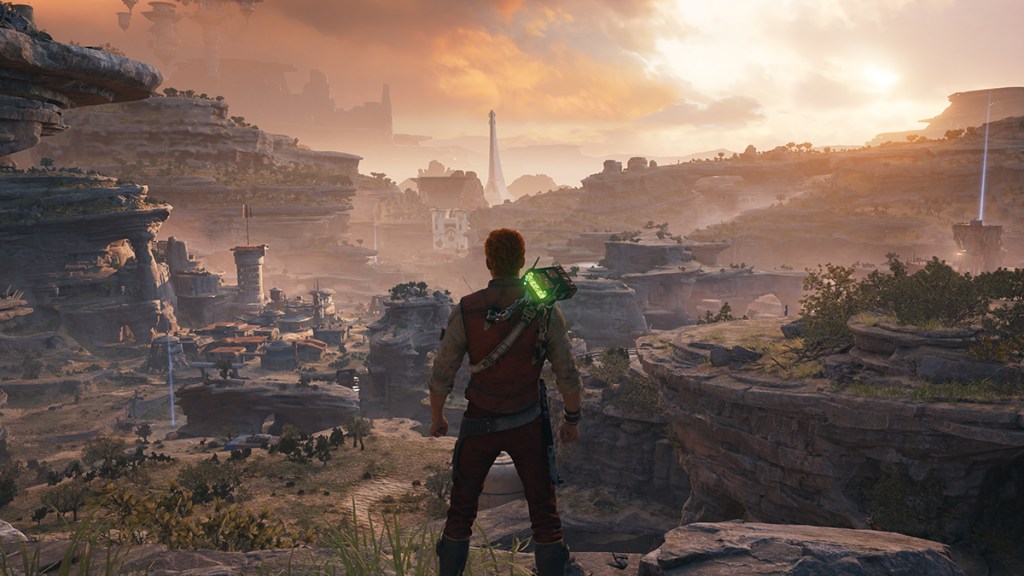
Survivor’s other parts are not as misguided because they are more focused. Platforming may suffer from occasional wonky mishaps, but wall-running, dashing, and chaining Force powers to get to new areas can make for exciting gauntlets that play like a superpowered version of Prince of Persia. The new special Force Tears are challenge courses built specifically around performing tricky maneuvers and excel because of Cal’s agility. New puzzle-oriented Jedi temples also utilize some of these skills but in a different, more methodical context that changes up the pacing while showcasing Cal’s athletic versatility.
Exploring Koboh, the game’s main planet, takes advantage of all of these skills with its winding paths and secret areas that invite players to poke around. There are intricate underground arenas, enemy bases, dark caves, and more that are filled with secret boss fights, collectibles, handy upgrades, and a wealth of cosmetics that all act as fitting rewards; it’s not just ponchos and lightsaber handles this time around. It’s always satisfying to stumble upon one of these places because the game doesn’t actively point toward them, as it only relies on chatter from NPCs and unfilled portions of the map to entice players to go spelunking. These small nudges make exploration more natural and flesh out Koboh so it is more than a flat and straightforward level.
And while Koboh is the most impressive level by a fair margin, it’s also where the game’s technical issues are the most prevalent. The frame rate simply is not stable in many areas of the big map, regardless of whether it is trying to hit 30 frames per second or 60. It stumbles elsewhere, too, as some of the more hectic battles on the other planets can cause the game to chug. Not even cutscenes are steady and many stutter when there’s not even much going on. Combined with other technical problems like screen tearing and intermittent bugs, Survivor, echoing Fallen Order’s lackluster launch, lacks polish and clearly needed to be delayed again. The game does look stunning at times with intricately detailed character models and environments, but visual splendor is not worth it if it comes at the cost of technical stability.
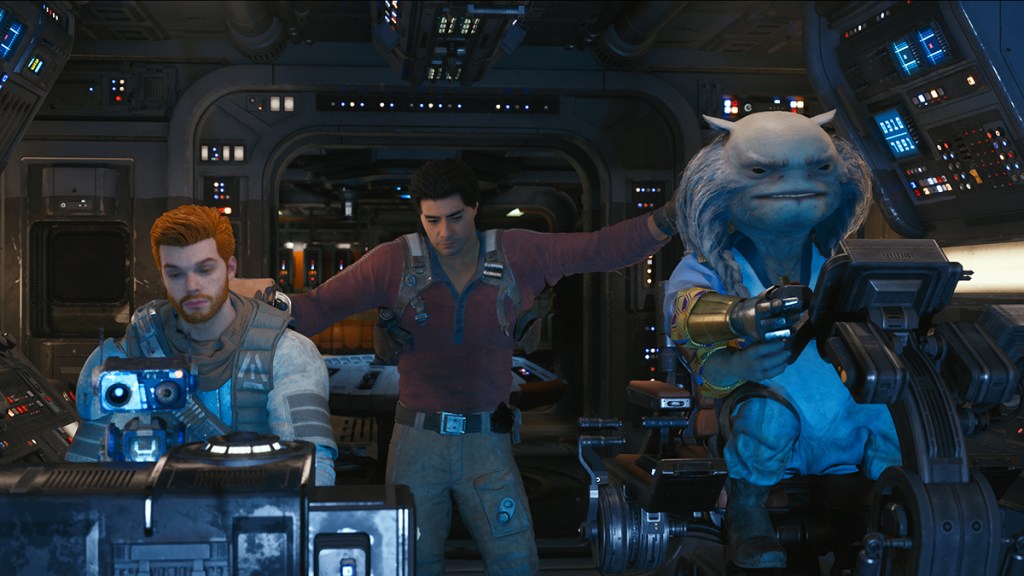
The narrative isn’t completely deflated by stuttery cutscenes since it has bigger problems than that and also stronger moments that a bad frame rate can’t distract from. Its cast is one of those highlights and even though Cal is still not the most charismatic lead, he’s surrounded by a bigger pool of interesting characters. There’s an optimistic droid from the High Republic era, a toad-looking goofball who constantly stumbles into trouble, a small fish guy in a diving suit with a thick Scottish accent and a love for long aquatic tales, and more that sit alongside the loveable cast from Fallen Order. The cantina on Koboh acts as a central hangout spot where everyone gathers and seeing this lively place grow over time is a highlight because every one of these characters is charming in their own way.
A handful of them play into the actual story, but it is still mainly about Cal and his crusade against the Empire. It touches upon his obsession with fighting such a bloody war and how that can break someone down and chip away at their soul to the detriment to them and the people around them. The more intimate angle to a larger-than-life conflict is what grounds everything here, and Survivor intelligently utilizes this theme in its main villain who is an unsubtle reflection of this struggle within Cal. As was echoed in the last game, balancing the Force within one’s self is a constant battle and watching Cal fight those urges here against a person that has clearly lost himself shows that he is still growing, which is crucial for a strong protagonist.
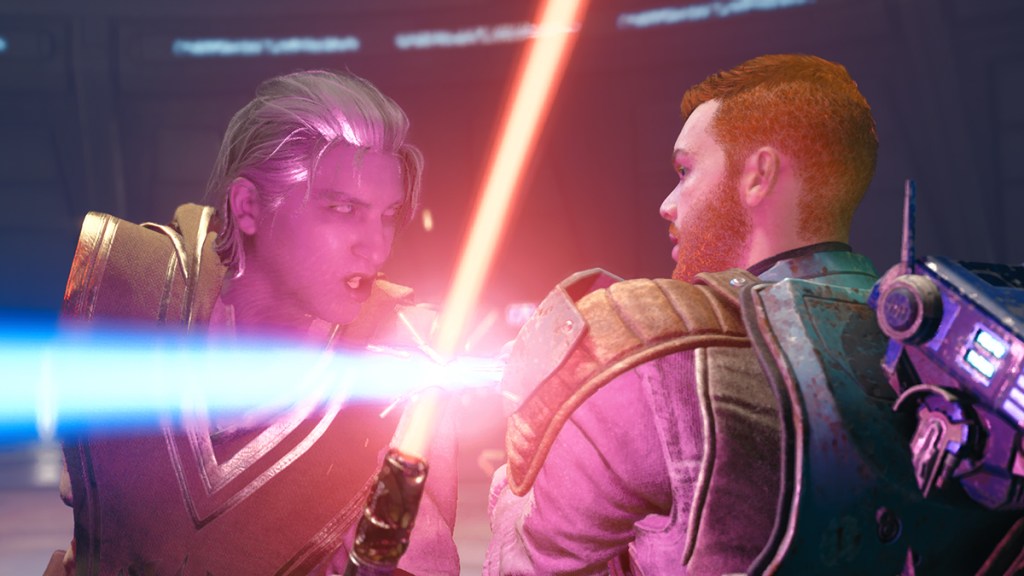
Survivor even plainly foreshadows possible avenues its sequel is going to tackle, showing that Cal still has demons to overcome at the end. There are other moments of clever foreshadowing limited to this specific story, but its final act abuses the notion altogether by throwing in a wildly out-of-nowhere twist to up the stakes. It does mirror Cal’s destructive obsession from a different angle, but the story doesn’t do the legwork ahead of time to justify the sudden shift. And when paired with another undeserved cameo that follows shortly after, Survivor sabotages a sizable portion of the momentum it has built up until then.
Star Wars Jedi: Fallen Order was a Padawan that was destined to be a Jedi Master with its next installment because of the solid base Respawn established. But instead of realizing its potential, Survivor squandered it by repeating many of the same problems and introducing new ones. Combat lacks the precision a parry-focused game requires and still tries to straddle the line between a soulslike and a faster action game, resulting in a conflicted and often frustrating experience. And while the story does bring up some ideas worth inspecting, its quality is diminished by its messy and unearned final act. It does hint at a more intriguing next chapter, but it’s not easy to have faith that yet another sequel will make good on its potential, given how disappointing Survivor is.
SCORE: 6.5/10
As ComingSoon’s review policy explains, a score of 6.5 equates to “Decent.” It fails to reach its full potential and is a run-of-the-mill experience.
Disclosure: The publisher provided a PlayStation 5 copy for our Star Wars Jedi: Survivor review. Reviewed on version 1.000.001.


